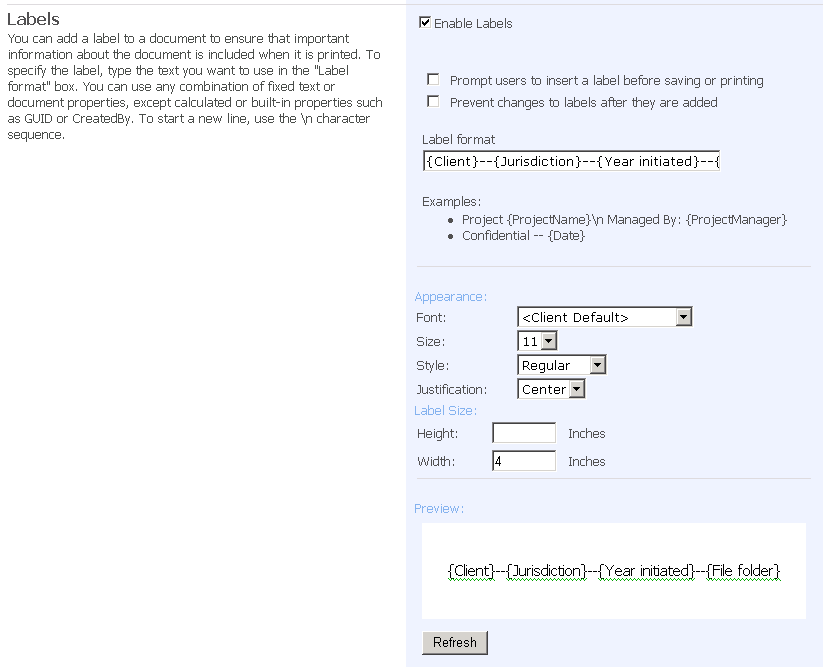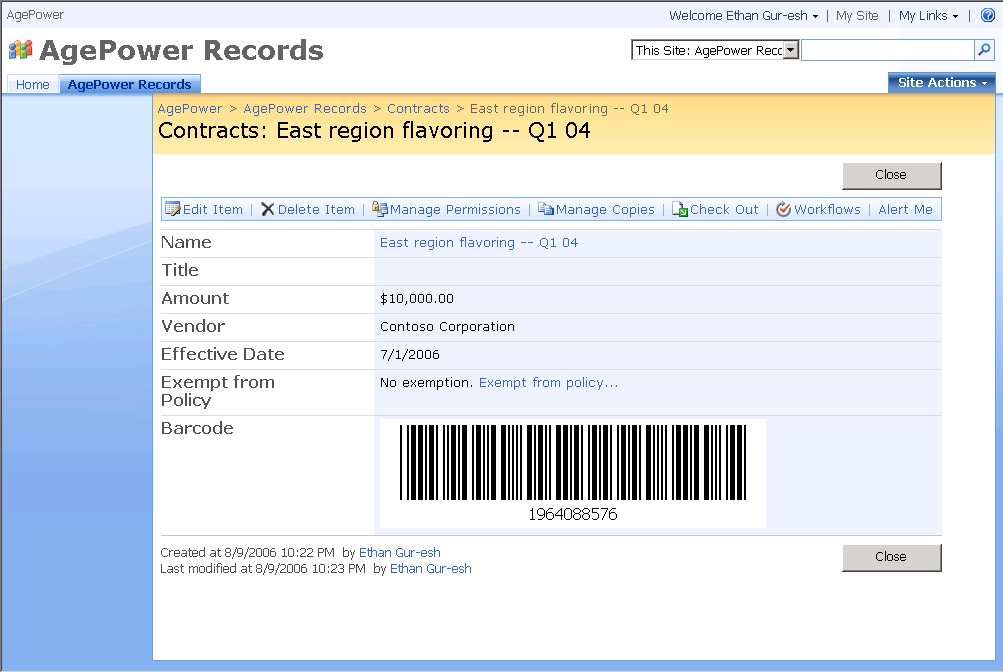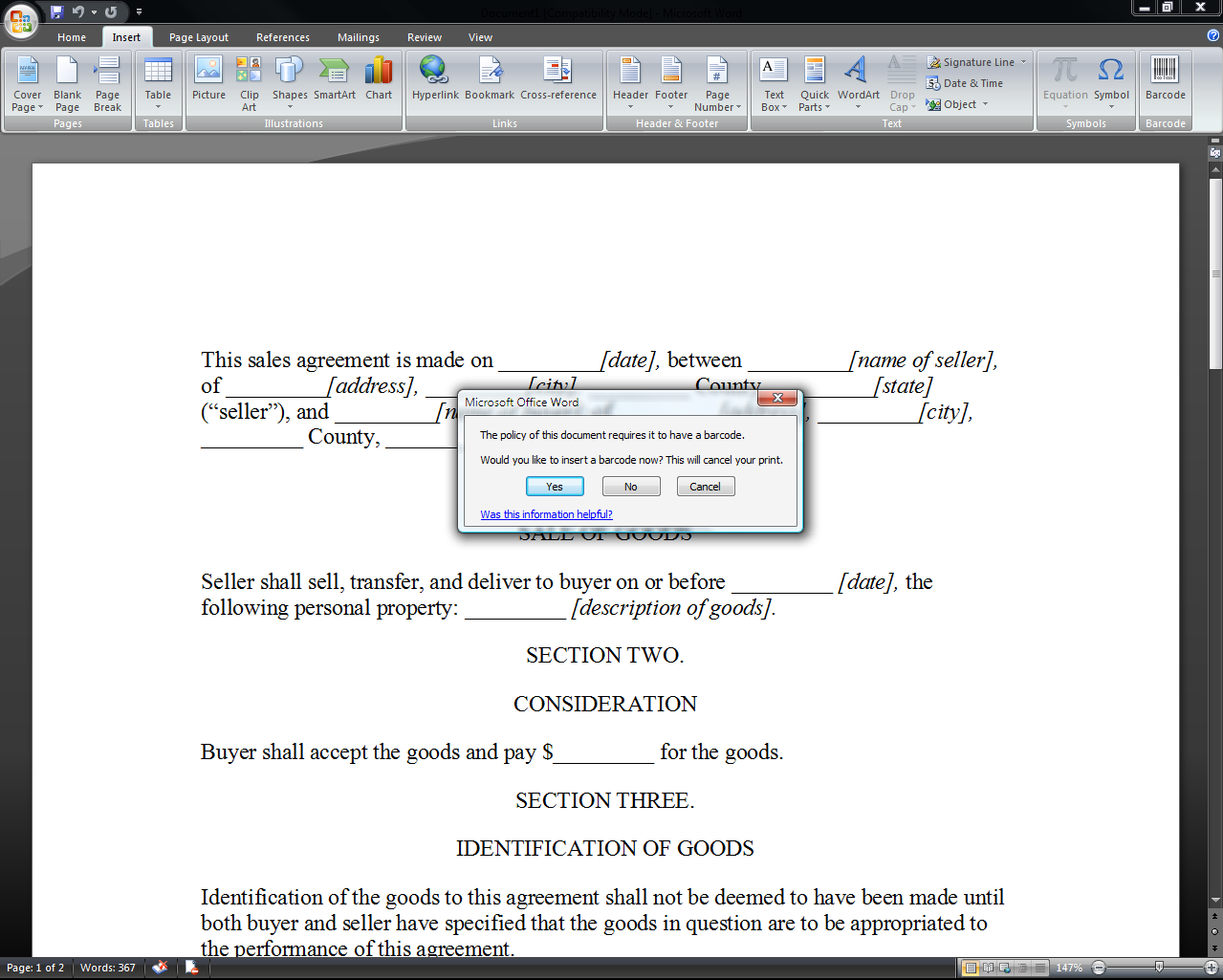Records Management Feature(s) – Barcode and Labeling Policies
Before moving on to our next topic of record declaration & classification (which I know that many of you are anxiously waiting to hear about), this week’s posting discusses the last two features in the Information Management Policy framework of the 2007 release of the Office system – labels & barcodes.
Both of these features target a problem of particular interest to records managers – namely, how to manage physical records or documents in a manner consistent with their electronic counterparts? This is of course, requirement #1 for using a Records Management Application to handle physical records – while the application stores a digital object that represents the record, containing metadata about the record (like where the physical record is being stored), the appropriate disposition schedule for the record, etc., users need a barcode or labeling system to identify which physical records correspond to which digital objects.
So in the 2007 release of the Office system, we’ve included features for labeling & barcodes to automatically assign identifiers to content.
What do you mean by labeling & barcodes?
When we talked to customers about how they assigned identifiers to objects, we heard two main approaches:
- Metadata-based labels: Some preferred to use an identification scheme that communicated metadata about the objects in the identifiers themselves. For example, some of our legal customers assigned identifiers to records that were based on the number of the client account, the jurisdiction of the matter in question, the year the matter was initiated, and the number of the folder that contained the record, like: Northwind—Massachusets—2006—001 .
- Machine-readable barcodes: Other customers preferred to use machine-readable identifiers like barcodes. While these didn’t communicate any information about the record directly, they could be read by scanner devices to automatically look up the record information from the application.
So in the 2007 release, we’ve provided features that can use either approach.
Label Policies:
Label policies are the mechanism for assigning metadata-based identifiers. Label policies specify how to assemble the metadata about an item or document into an identifier, and the label is automatically filled in as the metadata is entered. And the label can of course be searched for to locate items on the server.
Here is a screenshot of the settings page for configuring a Label policy:
Barcode policies:
Barcode policies (as you may expect) are the mechanism for assigning machine-readable identifiers. Once a barcode policy is applied to a Content Type, barcodes will automatically be assigned to items as they are created or uploaded to the system, and items can be searched for using their barcode value.
Here is a screenshot of an item that has been assigned a barcode via a policy:
The barcode format is totally configurable – Office SharePoint Server 2007 includes a component for generating barcodes that conform to the “Code 39” barcode symbology (formally known as ANSI/AIM BC1-1995), but components that provide barcodes in other formats can be plugged in as well.
Barcodes and labels in the Office 2007 client applications
And while everything mentioned above applies to managing any type of item or document in Office SharePoint Server, label & barcode policies have some additional capabilities when applied to Word, Excel, and PowerPoint documents.
Policies on these types of documents can specify that the label/barcode should be included in print-outs of these documents, and the Office 2007 applications will then provide users with an opportunity to add the label or barcode automatically when they print those documents out.
Here's a screenshot of a user printing out a document with a barcode policy:
In this way, document print-outs can be made to include the appropriate labels & barcodes to ensure that they can be easily correlated with the digital documents in Office SharePoint Server.
Thanks for reading!
- Ethan Gur-esh, Program Manager.
Comments
Anonymous
August 09, 2006
in 2007 we are adding records management to SharePoint.  I came across this great post on barcoding...Anonymous
August 10, 2006
Well, Code 39 or 3of 9 is widely used, but it doesn't have checksumming which can cause false positive reads - one old system I worked with used Code 128 codes with checksums, and provided a far more reliable label.
I'd also want to look at ways of guaranteeing uniqueness of generated numbers to the organization, as in government we have this tendency to transfer functions and the attached records between agencies, which results in a lot of duplicate labelling over time. I've often wondered if using the equivalent of a key generator would be much more effective than sequential schemes, which by nature will overlap. Any thoughts on this?
The policy attachment idea is very good. I can see a number of other applications in areas dealing with health/safety/child protection/security etc, anywhere confirmation or approval before release of information is critical. The question is of course, how to get this accepted in organizations with considerable cultural 'stickiness'?
Nice work, there seems to be some really switched on architecture in this.Anonymous
August 10, 2006
Great info! :)Anonymous
August 11, 2006
This is great info!Anonymous
August 11, 2006
Great stuff thanks!Anonymous
August 14, 2006
Here is an assortment of various 2007 Microsoft Office SharePoint Server Documentation / Reference Materials...Anonymous
August 16, 2006
The comment has been removedAnonymous
August 16, 2006
I don't think so, that random systems is the same the "key generator". I think that the "key generator" is @the one place" where you can get the bar-code value wit.h special rules( like you mention "sales" 200000).
In our case, we have one office with different locations, so we have to be sure that the bar code is not dublicated. As well we need the feature to get the barcode from electronic document when we put it in one databaseAnonymous
August 23, 2006
@ Igor:
Thanks for the correction. In that case what’s described as “key generator” is more like the “sequential” model I mentioned in my earlier comment. Hence the requirement to ensure that the identifier is not duplicated.
I’m not sure I followed your last requirement about “getting the barcode from electronic document when we put it in one database”. Can you clarify?
Thanks,
- Ethan Gur-esh.Anonymous
August 30, 2006
Planning Plan document management Chapter overview: Plan document management What is document management?Anonymous
September 19, 2006
Thanks to everyone who posted questions about the Records Center or sent them in via the “contact” form....Anonymous
October 04, 2006
So far in this blog, we’ve talked directly about electronic records – the files created in document authoringAnonymous
October 09, 2006
The comment has been removedAnonymous
October 16, 2006
The comment has been removedAnonymous
October 18, 2006
@recman: Thank you for the link, I'll try that ! My number has to be unique so I'll probably have to code my own barcodes generator...Anonymous
January 29, 2007
SharePoint's barcode feature does not guarantee that barcodes are generated every time a document is added to a document library. This has the consequence that two different documents can have the same barcode. Any workarounds?Anonymous
March 12, 2007
Recently I tried the barcode sample code from the ECM starter kit. (http://blogs.msdn.com/ecm/archive/2006/10/10/ECM-Starter-Kit-for-B2TR.aspx ) According to this example, adding a custom barcode seems to be not a big deal. I compiled the assembly and added to the GAC. I added the manifest with the small console application which is also in the sample package. That worked well! But now comes tha question. After adding the plug in, how can I use my custom barcode within sharepoint. If I create a new policy I do not see where I can select my custom barcode? I'm wondering if anybody has tried the ECM example?Anonymous
August 07, 2007
PingBack from http://calvin998.wordpress.com/2007/08/07/barcode/Anonymous
August 27, 2007
Hi, Is it possible to use the barcode and labeling feature in collaborative spaces? thx, Bela PesicsAnonymous
October 03, 2007
Document and Records Management Definition Document Management According to Wikipedia : "A documentAnonymous
October 23, 2007
We have customer who is thinking about sharepoint portal server, but ask us the following question:
- Using Record management or infopath form service (Infopath form) with textbox control pulling accountnumber from database, then generate barcode automatically, Is it possible to alter meta data and tie Unique id to read from database, in this case AccountNumber, then generate barcode accordingly when new form is created.
- Currently they print out blank form, then print out barcode using third party tool, then put the barcode on the form.
Anonymous
November 12, 2007
2007 MOSS Resource Links (Microsoft Office SharePoint Server) Here is an assortment of various 2007 MicrosoftAnonymous
December 12, 2007
PingBack from http://sharemypoint.wordpress.com/2007/08/07/barcode/Anonymous
March 05, 2008
IDAutomation offers several integration options for SharePoint Designer: http://idautomation.com/sharepoint/Anonymous
July 27, 2008
Document and Records Management Definition Document Management According to Wikipedia : "A documentAnonymous
June 18, 2009
PingBack from http://barstoolsite.info/story.php?id=6682Anonymous
June 19, 2009
PingBack from http://mydebtconsolidator.info/story.php?id=9642Anonymous
June 19, 2009
PingBack from http://debtsolutionsnow.info/story.php?id=4752Anonymous
November 01, 2011
this <a href="www.keepdynamic.com/.../csharp-barcode-generator.shtml">barcode generator</a> may be helpful for you.


